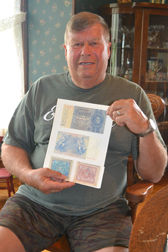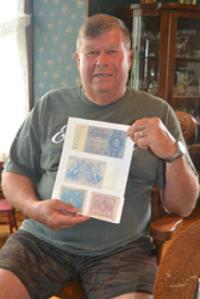SMETHPORT — “My dad was a young soldier stationed in Germany at the end of World War II when he received orders to report for duty as a cellblock guard at the Nuremberg Trials, where Hermann Goering was among the top Nazi defendants,” said Warren E. Semmel, a retired Smethport teacher and high school principal.
His father, Warren K. Semmel, was popularly known as “Johnny” in his Carbon County hometown of Lehighton, near the Poconos in eastern Pennsylvania.
After his parents died when he was 16 and still in high school, Warren Semmel dropped out of school and took a job with Swift and Co. About a year later, he enlisted in the U.S. Army, like many other boys his age. Through the war, he was a cook, also serving with his unit in France, Belgium, Czechoslovakia, Sicily, Tunisia and Algeria.
With his transfer to the Army’s 1st Infantry Division, which was given the responsibility for all 21 of the Third Reich’s military, political and economic leaders who were housed in a prison at the Palace of Justice in Nuremberg, Warren Semmel had a front seat as an eyewitness to history.
Several reasons led to Nuremberg’s selection as the site for this International Military Tribune’s trials, two of which were symbolic. Not only was this city where the Nazi Party staged its huge annual rallies and where the Nuremberg Laws, which stripped Jews of their basic rights and property were announced, but also the Palace of Justice, with its large seating capacity, was miraculously spared in the war, even though 91 percent of the city was destroyed.
A decorated World War I fighter pilot and an early Nazi Party, Goering founded the Gestapo and became commander-in-chief of the Luftwaffe and Reischmarschall, a rank above all other Wehrmacht commanders. He was Adolf Hitler’s heir-apparent until he realized the war was lost and attempted to negotiate with the Allies.
He surrendered to the Americans on May 6, 1945. At that time, Goering’s luggage was filled with 20,000 paracodeine pills — painkillers — to which he had become addicted after being shot in the leg during the Nazi Party’s attempted coup, the famous Beer Hall Putsch in 1923.
Goering was vain, in poor health and obese, probably due to his morphine addiction. He weighed 280 pounds.
The defendants, known as the “Big 21,” were charged with conspiracy, crimes against peace, war crimes and crimes against humanity.
“Actually, my dad and the other guards guarded all of the defendants on a rotating schedule,” Semmel said.
Each of the prisoners had his own small cell, outfitted with a chair, bed, a toilet in a small alcove and a table unable to support a person’s weight in order to prevent suicide attempts. Light shined in the cell 24 hours a day. Guards checked on the prisoners every 30 seconds 24/7 by peering through an open window that was about 15 inches square.
Semmel showed a copy of the guards’ special orders, which was labeled “Confidential and Restricted.” This document outlined the guards’ duties such as not allowing prisoners to escape, admitting personnel to the cell, keeping the door securely locked, collect all temporary passes. Another section of the document states that guards are armed with a pistol and seven rounds of ammunition and submachine gun and 20 rounds of ammunition.
Growing up in eastern Pennsylvania with a heavy German tradition, “Johnny” was familiar with Pennsylvania Dutch, a dialect of German spoken by the Amish, Warren said. “He used that knowledge to communicate with Goering in brief conversations.”
According to Semmel, “On Christmas Eve 1945, Dad was on duty and escorted Goering to Mass as a personal guard and sat beside him during the service.”
Goering was not necessarily that religious, but going to church was an opportunity to leave his small cell and four walls, even briefly.
Johnny, who stood 5’10” fell short of the minimum height requirement of six feet for sentries in the courtroom during the trials, which opened on Nov. 21, 1945, although he did observe the proceedings as a spectator. “I have the passes that he used to get into the courtroom,” Semmel noted, as he held up one from some of his dad’s war souvenirs.
Among Johnny’s souvenirs that he sent home were paper German money autographed by many of the Nazis on trial. Signatures on an Eine Mark #1 Alliierte Militarbehorde are those of Dr. Hans Frank, Eric Raeder, Col. Gen. Alfred Jodl, Karl Doenitz, Alfred Rosenberg, Hans Fritzsche, Goering and Wilhelm Frick. Frick also signed a 20 Mark #1 Alliierte Militarbehorde, Series 1944.
On a 20 Mark #2 Alliierte Militarbehorde, Series 1944, can be found the signatures of Joachim von Ribbentrop, Cell 7; Baldur von Schirach, Cell 29; Frank, Cell 15.
Hjalmar Schacht in Cell 24 and von Papen refused to sign German currency. “Since the war caused a paper shortage in Germany, dad tore off a triangular piece of an envelope, which carried letters from my mother, and Schacht signed it,” Semmel said. “Von Papen signed a rectangular piece of paper.”
Goering’s signature was also on a Reichsmart 100 and a Deutschland Mark Ein Mark, Series 1944.
Autographs, along with thjeir cell numbers of Dr. Seyes-Inquart, Cell 14; Albert Speer, Cell 45’ Wilhelm Keitel, Cell 8: Julius Streicher, Cell 25; Fritz Sauckel, Cell 11; Constantin von Neurath, Cell 10; Jodl, Cell 6; and Fritz Sauckel can be found an Eine Mark #2 Alliierte Militarbehorde.
The real currency is at secure location at another location out of the area.
Semmel said the guards who served during the trials were presented with distinctive military-style braided shoulder cords.
After eight months of testimony, the testimony ended and the justices began their deliberations.
On Oct. 1, 1946, the defendants were brought back to the courtroom to hear the verdicts. Eighteen were found guilty, of whom 11, including Goering, received the death penalty, and the others were given sentences ranging from 10 years to life in prison. Three were acquitted.
Goering, unrepentant to the end, requested to be shot, which he considered more appropriate for a soldier and regarded as an indignity. His request was denied.
Two hours before his scheduled hanging on Oct. 16, 1946, Goering committed suicide by biting on a potassium cyanide capsule that had been secreted or smuggled into his cell.





















